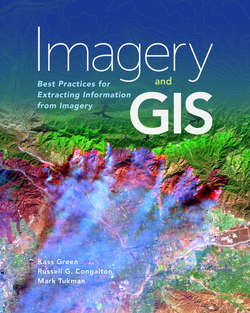Читать книгу Imagery and GIS - Kass Green - Страница 65
На сайте Литреса книга снята с продажи.
What types of features need to be mapped?
ОглавлениеThe types of features to be mapped will affect the spectral and temporal resolutions required. Mapping general land-use land-cover classes (e.g., urban versus agricultural versus water versus forests) can be accomplished with one date of panchromatic imagery. Identifying tree species usually requires multispectral imagery and is greatly enhanced if lidar is also available to measure tree height. Adding in multitemporal imagery will help distinguish deciduous from evergreen tree species, or to map different deciduous species from one another if they change colors differently during the fall or spring. Mapping crop types also requires multispectral imagery taken when the crops are established and growing. Mapping crop yield requires multispectral and multitemporal imagery. Coastal wetland mapping often requires careful coordination of the imagery collection with tidal and weather conditions, often necessitating collection of imagery at low tide on calm days so that a maximum amount of wetland vegetation is exposed, and wave action does not interfere with the vegetation’s spectral response. Mapping evapotranspiration (the transfer of water from land and plants to the atmosphere) requires thermal imagery.
Change detection requires multitemporal imagery. Change detection of obvious changes such as flooding, forest harvesting, or urban expansion can often be accomplished with multiple dates of panchromatic imagery because the spectral differences between to/from classes are very distinct. For example, clear-cuts do not look like forests, wildland and crop lands do not look like subdivisions, and the spectral response of water versus other land-cover types makes flood mapping fairly straightforward. Mapping subtle changes such as tree growth or crop production requires multitemporal, multispectral imagery and can be greatly aided by lidar.
Also important is the quality of calibration of the imagery. Calibration compensates for radiometric variation caused by sensor defects, system noise, and scan angle. Landsat sensors are methodically calibrated using preflight, postlaunch-onboard, and ground reference data. As a result, Landsat data is considered the gold standard of radiometric quality, and many other satellite systems calibrate their imagery to Landsat.
